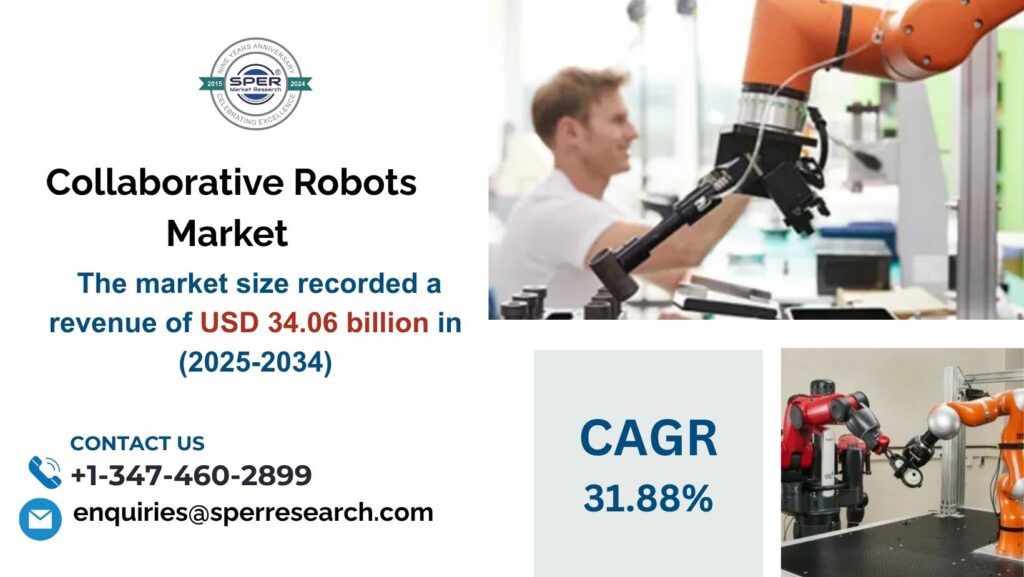Global Collaborative Robots Market ,Trends, Growth, and Forecast 2034

Collaborative robots, or cobots, are made to safely operate alongside human operators, increasing output and efficiency in a variety of sectors. Cobots, in contrast to conventional industrial robots, have sophisticated sensors and safety features that enable them to function without the need for substantial protective barriers. Material handling, assembling, packaging, welding, glueing, and quality control are just a few of the many jobs they can do. They are especially beneficial for small and medium-sized businesses due to their simplicity of implementation, inexpensive maintenance, and rapid return on investment. Furthermore, because of their adaptability and reprogrammability, cobots are perfect for dynamic manufacturing settings, boosting automation while enhancing overall operational efficiency and complementing human labour.
According to SPER market research, ‘Global Collaborative Robots Market Size- By Payload Capacity, By Application, By Industry Vertical- Regional Outlook, Competitive Strategies and Segment Forecast to 2034’ states that the Global Collaborative Robots Market is projected to be worth 34.06 billion by 2034 and is anticipated to surge at a CAGR of 31.88%.
Drivers:
Several key factors are propelling the Global Collaborative Robots Market. The collaborative robots market is largely fueled by increasing demand in logistics and e-commerce. As online shopping expands, warehouses must handle higher order volumes efficiently, creating a need for automation. Cobots enhance operational efficiency by performing repetitive tasks with accuracy, while also offering flexibility and scalability to optimize space utilization and streamline order fulfillment. They help reduce labor costs, improve data management, and enhance warehouse security. Beyond logistics, cobots are utilized in industries such as pharmaceuticals, aerospace, and food. The ongoing integration of cobot technology across these sectors is driving demand for more advanced, feature-rich collaborative robots, supporting productivity and operational optimization.
Download the Detailed Analysis in PDF format, Here
Restraints:
The market for collaborative robotics confronts a number of obstacles despite the rising demand for cobots. The expensive initial development cost is a significant barrier that puts pressure on budgets, especially for small and medium-sized businesses.This cost varies depending on payload capacity, safety measures, and necessary customisation. Although cobots are very adaptable and easy to utilize for simple, repetitive chores, their inability to do heavy-duty tasks may limit the market’s growth. Growth may also be impacted by the rivalry from conventional industrial robots and the sluggish technological development of heavy-duty collaborative robots. A major restraint in the collaborative robots market is the high initial development cost, especially for small and medium-sized businesses.
The Global Collaborative Robots Market is dominant in North America due to advanced manufacturing infrastructure, high adoption of automation, a strong focus on workplace safety, and significant investments in industrial robotics technology. Some significant market players are ABB Group, AUBO (BEIJING) ROBOTICS TECHNOLOGY CO., LTD, Comau S.p.A., DENSO Corporation, Energid Technologies Corporation, Epson America Inc., Fanuc Corporation, KUKA AG, Rethink Robotics GmbH, Robert Bosch GmbH, Techman Robot Inc., Universal Robots.
For More Information, refer to below link: –
Collaborative Robots Market Growth
Related Reports:
Melanoma Therapeutics Market Growth
Global Plantar Fasciitis Treatment Market Growth
Follow Us –
LinkedIn | Instagram | Facebook | Twitter
Contact Us:
Sara Lopes, Business Consultant — USA
SPER Market Research
enquiries@sperresearch.com
+1–347–460–2899





